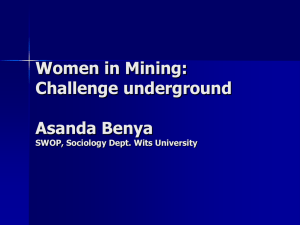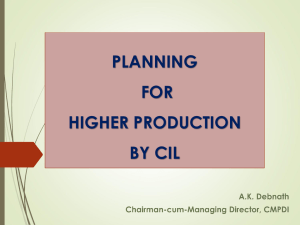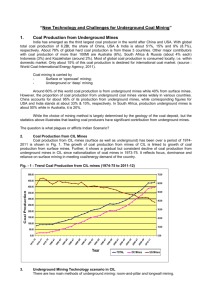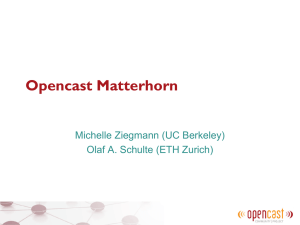Essentials for Enhancing Coal Production
advertisement
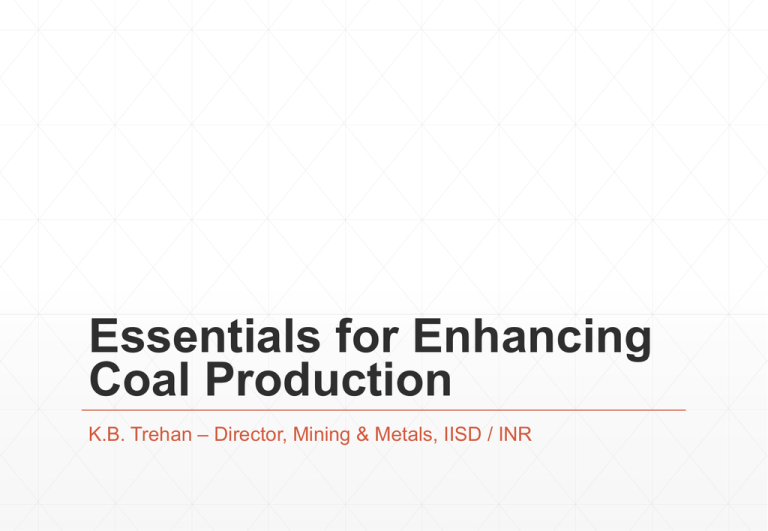
Essentials for Enhancing Coal Production K.B. Trehan – Director, Mining & Metals, IISD / INR Agenda 1. Expand the reserve and resource base 2. Focus on enhancing productivity 3. Speed up clearances 4. Equipment approvals 5. Essentials for high capacity mining 6. International best practices in contract management 7. Avoid regulatory overkill 8. Summary 2 1. Expand the reserve and resource base ▪ India is amongst the lowest spenders on mineral exploration in the major economies of the world. ▪ The total exploration (regional, promotional and detailed) drilling per annum in coal and lignite is around 2.5 lakh meters per annum with a spend of about Rs. 250 Cr. as against US$ 600 million in Australia ▪ The total quantum of drilling is to be increased to 20 lakh meters per annum with an outlay of around Rs.1500 Cr. - To be outsourced in a big way and relevant approvals to be expedited. $ per Sq. Km India Australia Canada 0 50 100 150 3 2. Focus on enhancing productivity ▪ Indian Coal mines have a long way to go in terms of productivity. ▪ The largest underground coal mine produces around 1MTPA whereas in USA, Russia, China, Australia and South Africa, it is 10 MTPA. Type of Mine CIL OMS (Metric Tons) USA (Metric Tons) Opencast 10.73 68.20 Underground 0.84 20.88 Overall 4.92 39.60 Activity India US, Australia, South Africa, Poland Shaft sinking: 400 mts 36 months 12 to 18 months Incline Drivage: 1000 mts 18 to 24 months 12 to 15 months Roadway Development 3 to 8 mts per day 3 mts per operating hour Lack of investment in technology is the principal reason. Contd. 4 2. Focus on enhancing productivity ▪ OC is a success story in India. Thanks to the vision of the mining industry leadership – Some of the Outsourced Opencast OBR contractors have Australian level of equipment availability, utilization and productivity. In UG Mines, Joy and Bucyrus operated CMs have set some productivity records. ▪ To replicate these success stories… Contd. 5 2. Focus on enhancing productivity ▪ Invest in “TECHNOLOGY, PEOPLE & SYSTEMS” – Three pillars of productivity. ▪ Focus on “Mining as a System” instead of each piece to be understood at all levels. ▪ Invest in “Training” – Shortage of skilled manpower or political difficulty of hiring right manpower. ▪ Coal companies should look at “lifecycle cost of equipment and cost per ton” instead of the cost of initial acquisition. ▪ Investing in high cost of equipment is worth only if they are going to be productive. ▪ Training people in advanced equipment and methods of working is a must. ▪ Provide “funding for equipment” (like some CIL collieries), as banks do not have expertise in lending to underground equipment. 6 3. Speed up clearances ▪ The present clearances: mine lease, mine plan, environmental approval, forest clearance take between 5 to 8 years; target it to reduce it to 2 years. ▪ EMP should take a maximum of 210 days but it takes 540 to 720 days. ▪ FC to be targeted in 150 days instead of 3 to 5 years. ▪ Banks have instructions not to lend to projects without completing land acquisition, R&R (100%), forest clearance and environmental clearance So?? Contd. 7 3. Speed up clearances The way forward ▪ Can we look at legally binding time limits? Technical opinion 5 months Opinion on forest land 5 months Revenue opinion 5 months Recommendation by State 4 months Approval by the Ministry 3 months ▪ Put up for bidding only those projects with complete clearances: Land is acquired fully, R&R is completed, EC and FC are in place; The bids will then be reasonable or else speculator bidders would win and projects will not take off. 8 4. Streamline approvals by DGMS ▪ DGMS and Coal Mining Companies in India are credited with good safety record and they are to be complimented. ▪ Concept and Awareness of “Zero Dangerous Occurrence“ to be introduced and reviewed for complete safety. ▪ The procedures are based on Coal Mines Regulations of 1957 and Indian Electricity Rules of 1956. ▪ There is a shortage of testing laboratories in India. For roof supports, there are no labs, leading to testing outside India thus, resulting in delays. No. of fatalities per million tons of coal India South Africa USA China 0 1 2 3 4 Contd. 9 4. Streamline approvals by DGMS The way forward ▪ Once approved and tested in an internationally recognized laboratory duly following internationally accepted testing processes, no further testing in India may be insisted. ▪ Systematic Support Rules, which specify the support pattern in underground mines, need to be revised continuously due to advances in technology, equipment and understanding of the roof strata. ▪ In the absence of above changes, the equipment market would be cornered only by a few established players, thus, stifling innovation and customer choice leading to higher prices and slower pace of technology absorption. 10 5. High Capacity Mining – Opencast & Underground ▪ Identify high capacity – 20 to 50 MTPA opencast mines: Deploy high capacity HEMM suiting mine specific conditions; ▪ In Underground Mines - 5 MTPA longwalls and 1 MTPA per CM board and pillar projects have to be identified. Maintenance and repair contracts Focus on faster mine development using Roadheaders, Bolter miners and achieve a progress rate of 3 meters per operating hour. Outsource development work and other services Outsource development work. Spares from OEM with performance guarantee, strategic warehouse locations – Minimize inventory carrying costs. Invest in Longwall mines –ploughs for thin seams and top coal caving for thick seams, for improving production, productivity and safety. Adopt global best practices in mining technology and management. Contd. 11 5. High Capacity Mining – Opencast & Underground ▪ Unless a critical market is created, no reputable OEM would invest in India to produce the equipment – all major OEMs have factories in China. ▪ In India too, all the Auto majors have manufacturing facilities – simple reason being scale of the market. Application of Auger / Highwall mining technology Phase out manual mining Track daily productivity and costs Contd. 12 5. High Capacity Mining – Opencast & Underground ▪ Cost Management Daily reporting of productivity and costs Electronic shift planning capability through shift data collection Provide data validation and upload at the end of each shift Web portal reporting Contd. 13 5. High Capacity Mining – Opencast & Underground ▪ Improving Efficiencies Plan for the long term Mine planning Production scheduling Safety Wash Plants yields Equipment selection Appropriate infrastructure PLANNING, PLANNING & MORE PLANNING -- Always consider the WHOLE production chain Contd. 14 5. High Capacity Mining – Opencast & Underground ▪ Integrate Systems & Technology Technology is often ignored, not understood, under utilized, poorly implemented and managed New technologies MEAN CHANGE & MUST BE MANAGED 15 6. International best practices in Contract Management Issues ▪ Risk sharing between the employer and the contractor is not equitable: LA, R&R, EC, FC need to be with the owner. ▪ Long term contracts do not have price variation clauses; and in contracts with price variation clause, the formula weightages do not reflect the cost components effectively. ▪ In composite EPC and Operations contracts, the liabilities of EPC phase do not end till the operation phase is concluded – No major OEM is willing to accept this. ▪ The acceptance criterion for performance tests are not clearly defined. ▪ Engineer’s role under the contract is that of a “referee” and not just “owner’s representative” – this aspect is completely ignored. Contd. 16 6. International best practices in Contract Management ▪ Prepare model contract documents as done by NHAI. ▪ Model documents are prepared by Secretariat for infrastructure in the Planning Commission and approved by the Cabinet Committee on Infrastructure headed by the Prime Minister for Airports, Roads, Highways, Power, Telecom and Railways. ▪ The same Secretariat could prepare and approve the model documents for the coal / mineral sector also. 17 7. Avoid regulatory overkill ▪ Legislators across the world are competing with each other leading to regulatory overkill Australia: Resource super profit tax, Strict Carbon Control laws USA : Closing down of coal based power plants which do not meet the strict carbon emission norms Indonesia: Royalty based on index price fixed by the Government India: 26% profit sharing for coal and lignite companies ▪ Investors do not worry about regulations but they are looking for fair, consistent and predictable application of regulations. ▪ Having an independent regulator who has the authority to regulate coal prices is imperative. 18 8. Transforming the Indian coal sector Summary 1. Expand the resource base by increasing the spend on EXPLORATION. 2. Invest in “PEOPLE, Technology & Systems.” 3. Focus on PRODUCTIVITY enhancement through TECHNOLOGY & TRAINING. 4. Speed up forest and environment CLEARANCES. 5. Streamline equipment approvals by DGMS. 6. Identify high impact OC and UG projects and bring them to production in a well defined TIME frame with TRAINED skilled manpower, tracking operations SHIFTWISE, Cost Management & integration of Systems & Technology. 7. Use international BEST practices in contract management. 8. Avoid regulatory overkill. 9. Lets be “VALUE CONSCIOUS” and not “Cost Conscious.” 19
